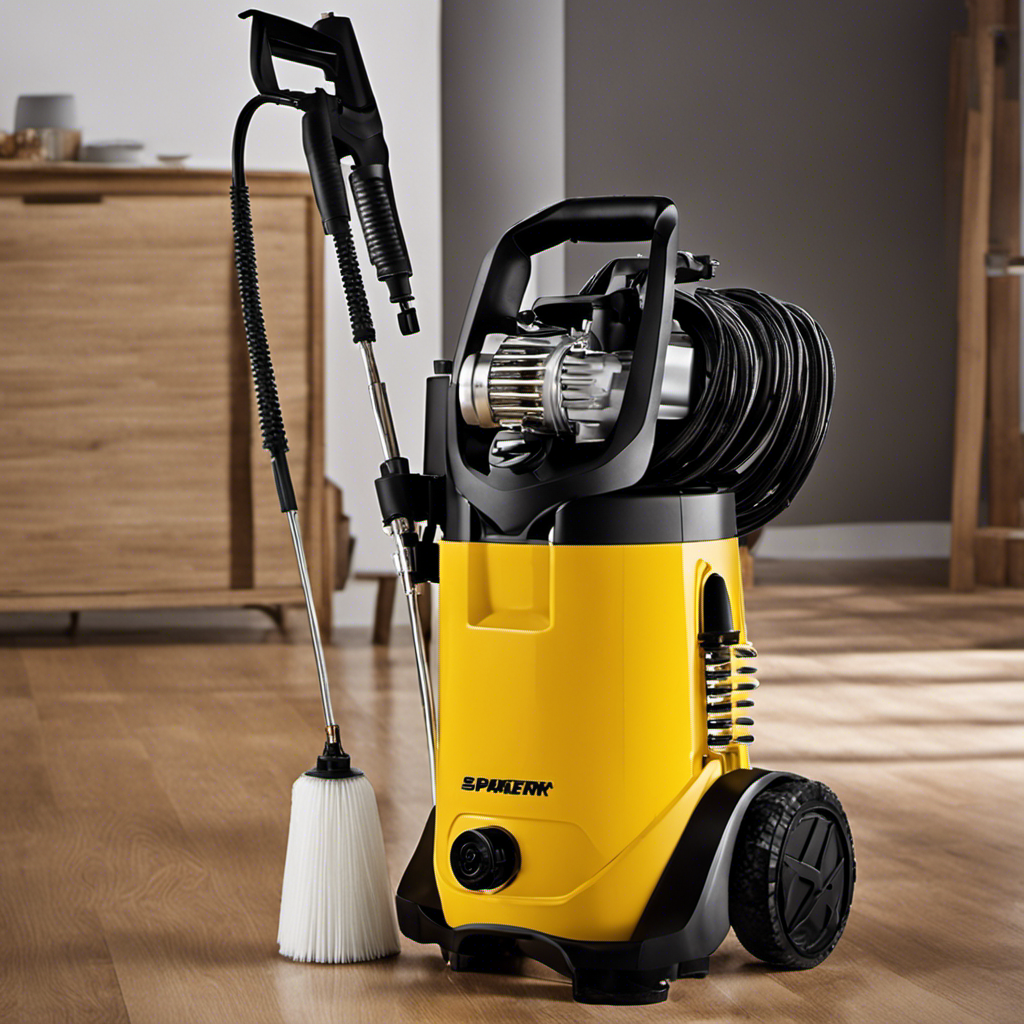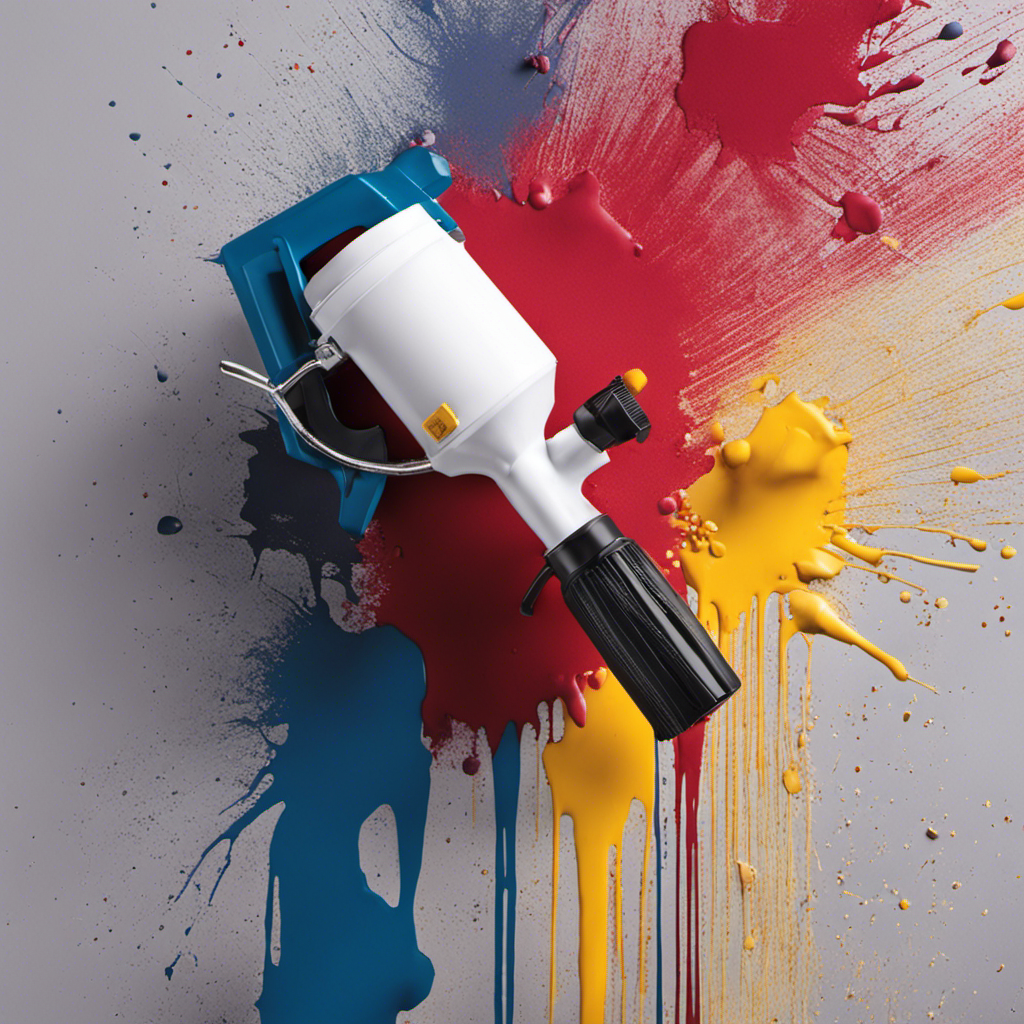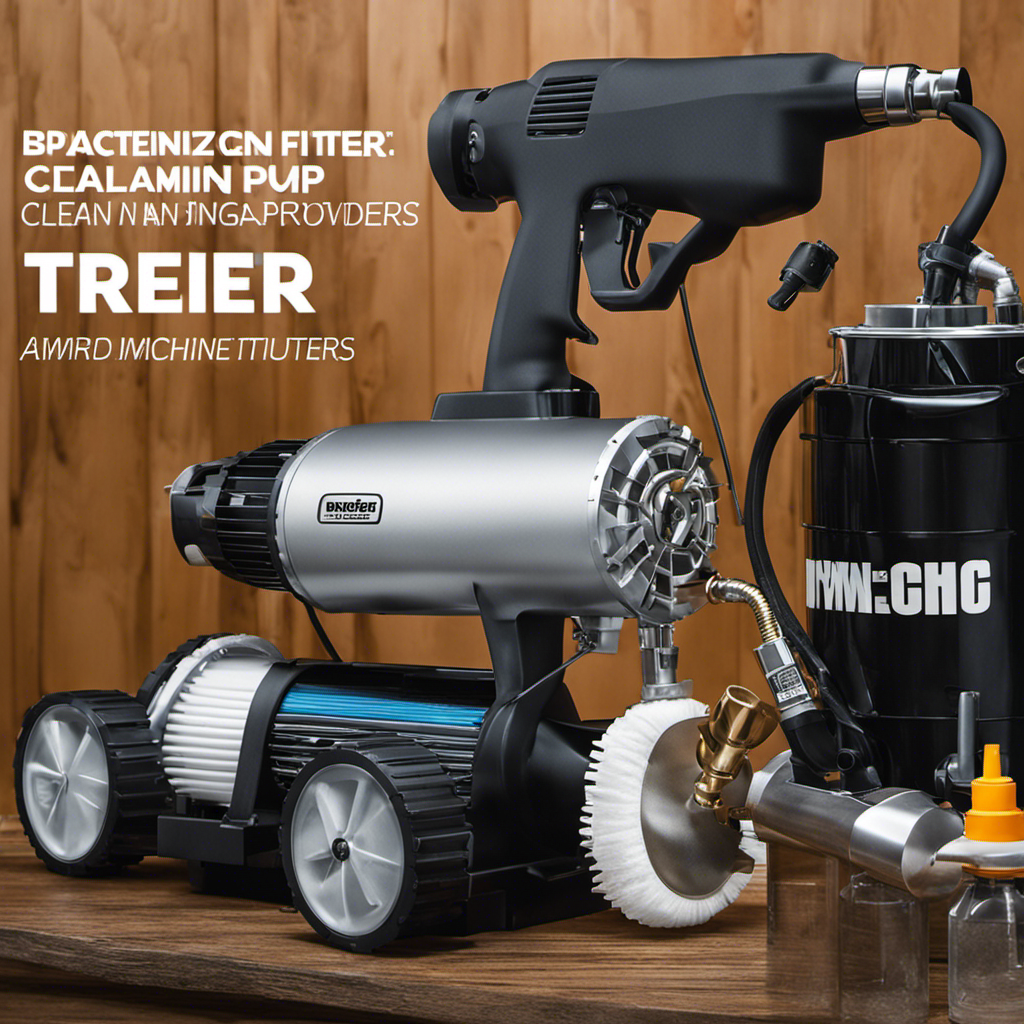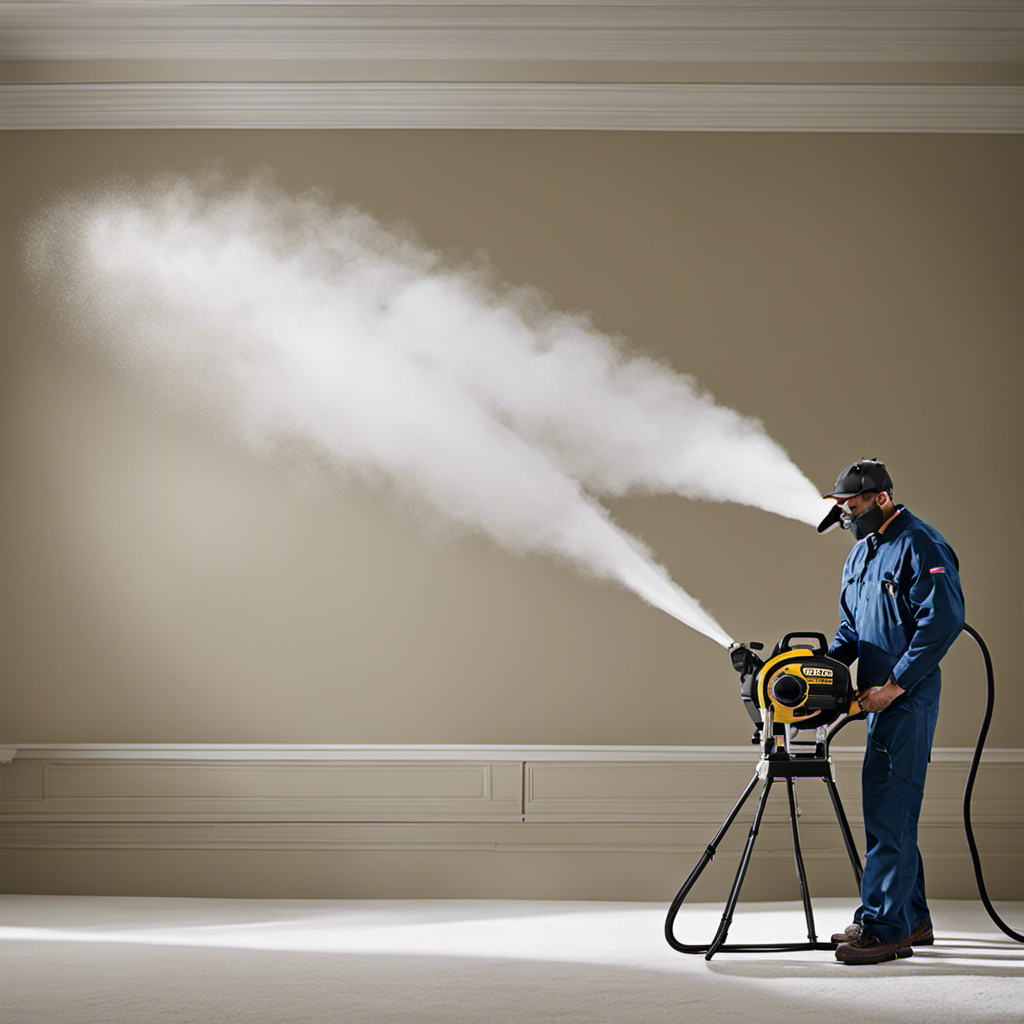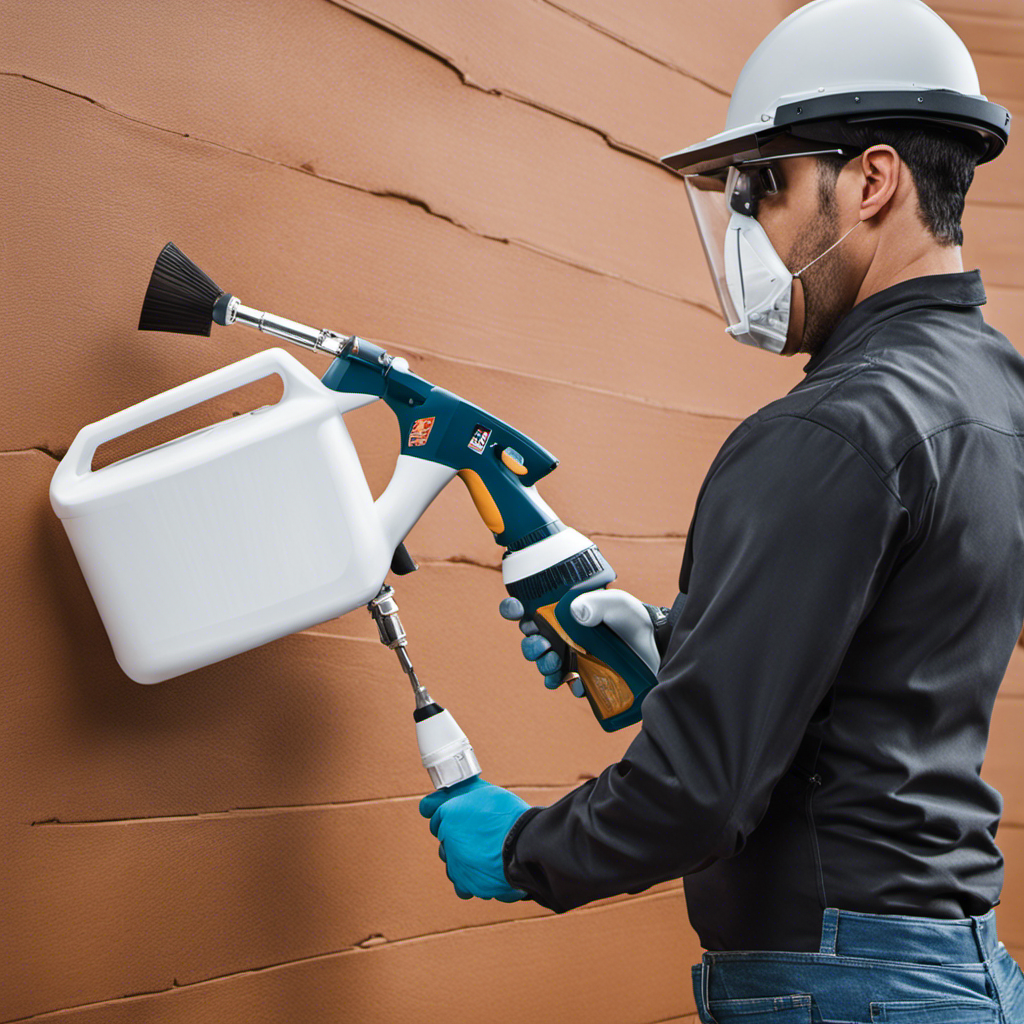Are you fed up with your paint sprayer malfunctioning when you need it the most? No need to fret, we’ve got your back!
In this article, we’ll provide you with essential tips to maximize the lifespan of your airless paint sprayer. Imagine a paint sprayer that lasts longer, performs reliably, and saves you time and money.
By following these simple yet effective techniques, you’ll ensure proper storage, regular cleaning, and maintenance, and the use of high-quality replacement parts.
So, let’s dive in and make your airless paint sprayer last for years to come!
Key Takeaways
- Proper storage and protection: Clean and dry the sprayer before storage, find a cool and dry place, invest in a protective case, and keep it away from extreme temperatures and moisture.
- Regular cleaning: Clean the spray gun after each use, check and clean the filters regularly, flush out the system, and keep the storage area clean to prevent clogs and blockages.
- Lubrication: Follow manufacturer’s recommendations for oil type and usage, regularly check oil levels, and apply oil to moving parts for smooth operation.
- High-quality replacement parts: Invest in durable and reputable replacement parts, replace worn-out or damaged parts promptly, and use genuine parts to maintain performance and reliability.
Proper Storage and Protection
To maximize your airless paint sprayer’s lifespan, follow these steps:
- Clean the sprayer thoroughly before storage. Ensure all components are dry.
- Find a cool and dry place to store the sprayer.
- Proper sprayer maintenance and effective storage techniques are crucial for keeping your equipment in optimal condition.
After each use:
- Clean the spray gun and check and clean the filters regularly.
- Flush out the entire system with water or a cleaning solution to prevent clogs and blockages.
- Lubricate the sprayer with the manufacturer-recommended oil to reduce friction, wear, and corrosion.
Remember to:
- Invest in high-quality replacement parts to ensure durability and functionality.
- Cheap parts wear out quickly and require frequent replacements.
Thorough Cleaning
Regularly clean the spray gun after each use to prevent clogs and maintain optimal performance. Thorough cleaning techniques are essential to ensure the longevity of your airless paint sprayer.
Start by disassembling the spray gun and removing any paint residue or debris. Use a cleaning solution recommended by the manufacturer and thoroughly clean all the components, including the nozzle and filter.
Pay close attention to the hoses, as they can also become clogged with dried paint. Flush out the entire system with water or the appropriate cleaning solution to ensure all paint particles are removed.
After cleaning, dry all the components thoroughly before reassembling the spray gun. By following these thorough cleaning techniques and using the best cleaning solutions, you can keep your airless paint sprayer in optimal condition and avoid any performance issues.
Regular Filter Maintenance
Ensure you clean and inspect the filters of your airless paint sprayer on a consistent basis to maintain optimal performance. Cleaning the filters regularly is essential to prevent clogs and ensure smooth operation.
The frequency of cleaning will depend on the type and amount of paint being sprayed. As a general rule, it’s recommended to clean the filters after every use or at least once a week for heavy use.
Start by removing the filters from the sprayer and rinse them thoroughly with water or a cleaning solution. Use a soft brush or toothbrush to remove any stubborn debris. Allow the filters to dry completely before reinserting them into the sprayer.
Regularly checking and cleaning the filters will prolong the lifespan of your airless paint sprayer and ensure consistent, high-quality results.
Flushing the System
Flushing the system is an important step in maintaining the performance of your airless paint sprayer. Regular system maintenance ensures optimal performance and prevents clogs or blockages.
To flush the system, start by removing any remaining paint from the sprayer. Then, fill the paint container with a cleaning solution recommended by the manufacturer.
Attach the sprayer to a water source and turn it on. Allow the cleaning solution to flow through the system, flushing out any paint residue or debris. Run the cleaning solution through all components, including the hoses, filters, and nozzle.
Once the cleaning solution runs clear, disconnect the sprayer from the water source and thoroughly rinse the system with clean water.
This flushing technique will help maintain the efficiency and longevity of your airless paint sprayer.
Clean Storage Area
To maintain the cleanliness of your storage area, keep it free from dust or dirt that could potentially enter critical components. Here are some cleaning techniques and tips to prevent dust accumulation:
- Regularly dust and sweep the storage area to remove any loose dirt or debris.
- Use a vacuum cleaner with a brush attachment to clean hard-to-reach areas.
- Wipe down surfaces with a damp cloth to remove any stubborn dust or grime.
- Consider using air purifiers or dehumidifiers to maintain a clean and dry environment.
Store your airless paint sprayer in a protective case or bag to prevent dust from settling on it. Avoid storing the sprayer in areas prone to moisture or dust, such as basements or garages. Cover the sprayer with a cloth or plastic sheet when not in use to further protect it from dust.
Nozzle and Filter Cleaning
Now that you understand the importance of keeping your storage area clean, let’s move on to the next crucial aspect of maintaining your airless paint sprayer: nozzle and filter cleaning.
Regularly cleaning the nozzle and filters is essential for optimal performance and preventing common nozzle issues.
To start, always follow the manufacturer’s instructions for cleaning the nozzle. Typically, this involves removing the nozzle from the spray gun and soaking it in a cleaning solution or using a specialized cleaning brush to remove any paint residue or debris. Be sure to clean the nozzle thoroughly, as any build-up can lead to clogs or uneven spray patterns.
Additionally, it’s crucial to regularly check and clean the filters. These filters help prevent debris from entering the sprayer and can become clogged over time. Simply remove the filters and rinse them with water or a cleaning solution, ensuring all dirt and debris are removed.
Hose Inspection and Cleaning
Make sure you regularly inspect and clean the hoses of your airless paint sprayer to ensure optimal performance. Here are some troubleshooting tips for hose maintenance:
- Check for any cracks or leaks in the hoses
- Inspect the hose fittings for any signs of wear or damage
- Clean the hoses thoroughly after each use to remove any paint residue or debris
- Use a soft brush or cloth to clean the exterior of the hoses
- Flush out the hoses with water or a cleaning solution to remove any clogs or blockages
- Pay attention to any kinks or twists in the hoses and straighten them out if necessary
- Replace any damaged or worn-out hoses promptly to prevent further issues
- Store the hoses in a clean and dry area to prevent them from being exposed to moisture or dust
Lubrication Guidelines
Ensure you consult the manufacturer’s recommendations for the correct oil type to use in your airless paint sprayer. Using the right oil is crucial for optimal performance and longevity. Lightweight mineral-based oil designed for high-pressure applications is typically recommended.
Regularly check the oil level in your sprayer and top up or change the oil as recommended by the manufacturer. Following the proper oiling frequency is important to reduce friction, wear, and corrosion. Apply oil to moving parts to ensure smooth operation, but be cautious not to over-lubricate as it can attract dust and debris.
Regularly check oil levels and refill as needed to maintain the sprayer’s efficiency. By using the appropriate oil and following the recommended lubrication frequency, you can maximize the lifespan of your airless paint sprayer.
Correct Oil Type
Using the recommended lightweight mineral-based oil for high-pressure applications is crucial to ensure optimal performance and longevity of your airless paint sprayer. Choosing the right oil and proper lubrication techniques are essential for maintaining your sprayer.
Here are some key points to consider:
- Use a lightweight mineral-based oil designed for high-pressure applications.
- Regularly check the oil level in the sprayer and top up or change it as recommended.
- Proper oil usage reduces friction, wear, and corrosion in the internal components.
- Apply oil to the moving parts to ensure smooth operation.
- Avoid over-lubricating, as it can attract dust and debris.
- Follow the manufacturer’s guidelines for oiling frequency.
- Regularly check oil levels and refill as needed.
Regular Oil Level Check
Check the oil level in your sprayer regularly to ensure optimal performance and prevent unnecessary wear and tear.
Regular oil level monitoring is crucial for maintaining the efficiency of your airless paint sprayer. Oil acts as a lubricant, reducing friction and preventing corrosion within the internal components.
By regularly checking the oil level and topping up or changing it as recommended by the manufacturer, you can ensure smooth operation and extend the lifespan of your sprayer.
Regular oil changes are important because over time, the oil can become contaminated with debris and lose its lubricating properties. By staying on top of oil changes, you can prevent damage to the sprayer and avoid costly repairs.
Make it a habit to monitor the oil level in your sprayer and perform regular oil changes to keep it running smoothly.
High-Quality Replacement Parts
When it comes to maintaining your airless paint sprayer, using high-quality replacement parts is essential. Genuine parts offer several benefits that can significantly impact the lifespan and performance of your sprayer.
Here are some reasons why using genuine parts is important:
-
Superior Durability and Functionality:
- Genuine parts are designed specifically for your sprayer model, ensuring a perfect fit and optimal performance.
- They are made from high-quality materials, making them more durable and resistant to wear and tear.
- Using genuine parts eliminates the risk of leaks or malfunctions, providing a reliable and efficient spraying experience.
-
Reduced Repairs and Downtime:
- High-quality replacement parts minimize the need for frequent repairs, saving you time and money.
- Genuine parts are less likely to fail or break, preventing unexpected project delays.
- By investing in genuine parts, you can avoid costly downtime and keep your sprayer working at its best.
-
Maintenance and Reliability:
- Genuine parts are manufactured to meet the highest standards, ensuring consistent performance and reliability.
- Regular maintenance, including the use of genuine replacement parts, is crucial for maximizing the lifespan of your sprayer.
- By following recommended maintenance practices and using genuine parts, you can enjoy a reliable and long-lasting airless paint sprayer.
Importance of Premium Parts
Investing in high-quality replacement parts for your airless paint sprayer is essential for durability and optimal performance. Premium parts offer several benefits. Firstly, they are designed to fit and function perfectly, eliminating leaks or malfunctions that can occur with cheaper alternatives. Additionally, premium parts have a longer lifespan, reducing the need for frequent replacements. When choosing replacement parts, consider reputable manufacturers who offer warranties for their products. Ensure that the replacement parts are compatible with your specific sprayer model. Using genuine parts is crucial to maintain performance and reliability. By investing in high-quality replacement parts, you can minimize repairs, extend the lifespan of your sprayer, and ultimately save time and money in the long run.
Reputable Manufacturers for Replacement Parts
Look for warranties provided by reputable manufacturers to ensure the quality and reliability of replacement parts for your airless paint sprayer.
When it comes to finding reliable suppliers for replacement parts, here are a few things to consider:
-
Warranty coverage: Reputable manufacturers often offer warranties on their replacement parts, giving you peace of mind and assurance that the parts are of high quality and built to last.
-
Reputation: Look for manufacturers with a strong reputation in the industry. Reliable suppliers are known for producing top-notch replacement parts that meet or exceed industry standards.
-
Compatibility: Ensure that the replacement parts you choose are compatible with your specific airless paint sprayer model. Reputable manufacturers provide detailed information about compatibility to help you make the right choice.
Timely Replacement of Worn-Out Parts
To ensure optimal performance, regularly replacing worn-out parts is crucial for keeping your airless paint sprayer running smoothly. Timely replacement of worn-out parts is essential for the proper functioning of your sprayer and to avoid any potential breakdowns during your painting projects.
By replacing worn-out parts in a timely manner, you can prevent further damage to your sprayer and ensure its longevity. Not only does timely replacement of parts help maintain the performance of your sprayer, but it also has numerous maintenance benefits. It reduces the risk of malfunctions, leaks, and inefficient paint application. Additionally, it minimizes the need for costly repairs and downtime, saving you both time and money.
Cost and Time Savings With Proper Maintenance
To ensure maximum longevity and performance from your airless paint sprayer, regular maintenance is crucial. By investing a little time and effort into proper care, you can save yourself both money and time in the long run.
Here are the key reasons why regular maintenance is important and the benefits of investing in a protective case:
-
Importance of Regular Maintenance:
- Prevents clogs and blockages, ensuring smooth operation and consistent spray patterns.
- Reduces friction, wear, and corrosion, extending the lifespan of your sprayer.
- Protects the sprayer from cold-related issues, such as freezing or damage to seals and valves.
-
Benefits of Investing in a Protective Case:
- Shields the sprayer from accidental drops, bumps, and impacts.
- Guards against dust, moisture, and other environmental factors that can damage critical components.
- Provides convenient storage and organization for accessories and spare parts.
Frequently Asked Questions
How Often Should I Clean the Spray Gun After Each Use?
To ensure optimal performance, clean the spray gun after each use. This is a crucial step in airless paint sprayer maintenance. Use a cleaning solution recommended by the manufacturer and thoroughly clean all components, including the nozzle and filter.
Regular cleaning prevents clogs and blockages, ensuring smooth operation. By following best practices for cleaning your airless paint sprayer, you can maximize its lifespan and avoid costly repairs.
Can I Use Any Type of Oil for Lubricating the Airless Paint Sprayer?
Yes, you can use any type of oil for lubricating your airless paint sprayer. However, it is important to use the correct oil recommended by the manufacturer for optimal performance and lifespan.
Using the wrong type of oil can lead to friction, wear, and corrosion, causing damage to the internal components. Avoid common mistakes in lubricating airless paint sprayers by consulting the manufacturer’s guidelines and using lightweight mineral-based oil designed for high-pressure applications.
Regularly check the oil level and refill as needed to ensure smooth operation.
How Frequently Should I Check and Clean the Filters?
To extend the lifespan of your airless paint sprayer, it’s important to regularly check and clean the filters. This ensures optimal performance and prevents clogs and blockages. The frequency of checking and cleaning the filters depends on the usage and the type of paint being sprayed.
However, as a general guideline, it is recommended to check and clean the filters after every use or at least once a week for heavy usage. Proper maintenance of the filters will help maximize the lifespan of your airless paint sprayer.
What Are the Benefits of Using High-Quality Replacement Parts?
Using high-quality replacement parts for your airless paint sprayer offers a multitude of benefits. These durable parts ensure proper functionality, eliminating leaks and malfunctions. By investing in premium parts, you can reduce the need for frequent repairs and project downtime.
This not only saves you time but also money in the long run. High-quality replacement parts extend the lifespan of your sprayer, providing reliable performance and enhancing efficiency. So, opt for reputable manufacturers and genuine parts to maximize the durability and longevity of your airless paint sprayer.
How Can Proper Maintenance of the Airless Paint Sprayer Save Me Money and Time in the Long Run?
Proper maintenance of your airless paint sprayer can save you both time and money in the long run. By ensuring proper storage, you protect the sprayer from damage caused by extreme temperatures, moisture, and dust.
Regular maintenance, such as cleaning the spray gun and filters, prevents clogs and blockages that can lead to costly repairs. Using high-quality replacement parts enhances efficiency and reduces project downtime.
Taking these steps will maximize the lifespan of your airless paint sprayer and provide reliable performance.
Conclusion
So there you have it, with these essential tips, you can maximize the lifespan of your airless paint sprayer and enjoy its reliable performance for years to come.
By properly storing and protecting your sprayer, cleaning it thoroughly after each use, and regularly maintaining the filters and system, you can ensure its longevity.
Investing in high-quality replacement parts from reputable manufacturers and timely replacements of worn-out parts will also contribute to cost and time savings.
So take care of your airless paint sprayer and witness the benefits of proper maintenance firsthand.
Franz came aboard the Paint Sprayer Zone team with a background in both journalism and home renovation. His articulate writing style, combined with a passion for DIY projects, makes him an invaluable asset. Franz has a knack for breaking down technical jargon into easy-to-understand content, ensuring that even the most novice of readers can grasp the complexities of paint sprayers.
